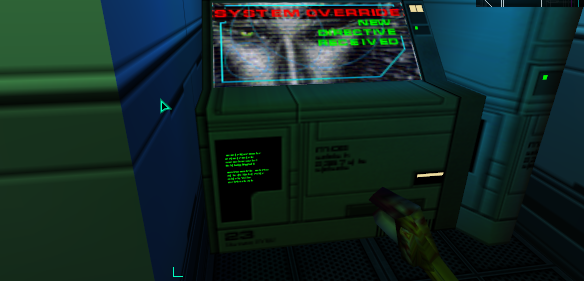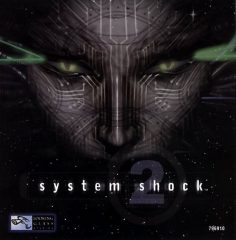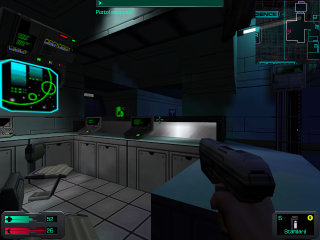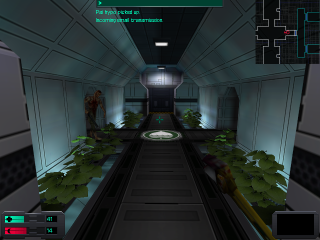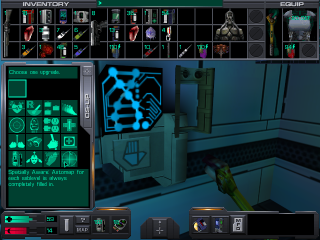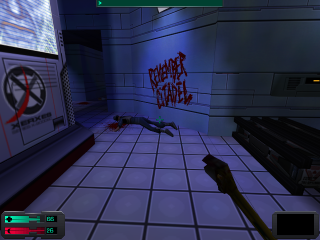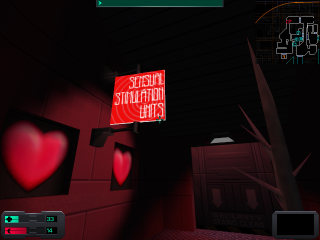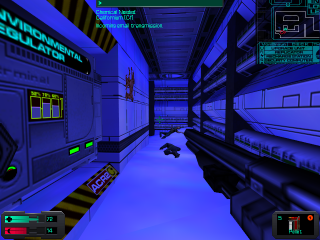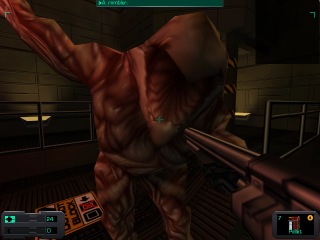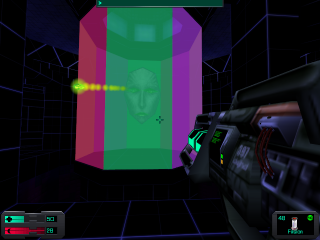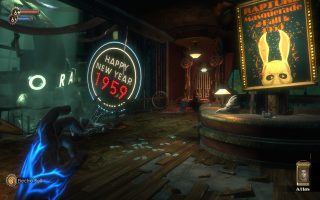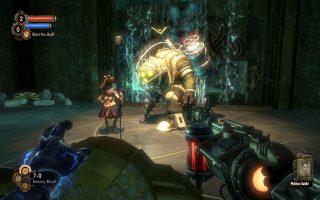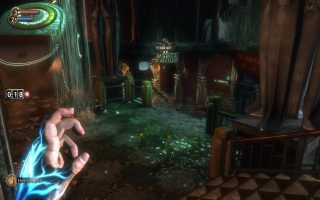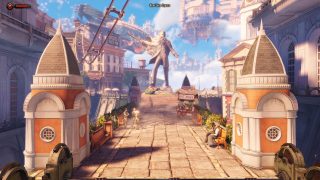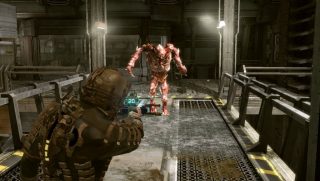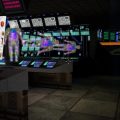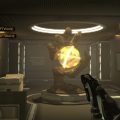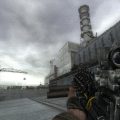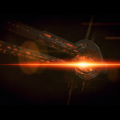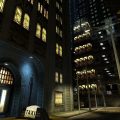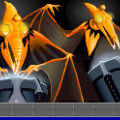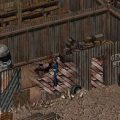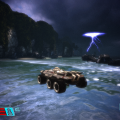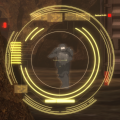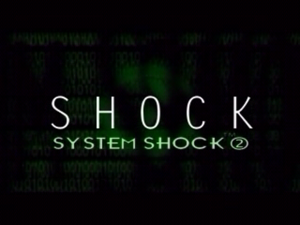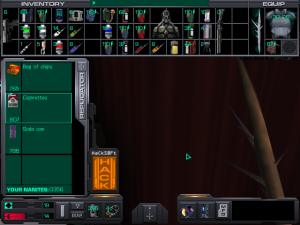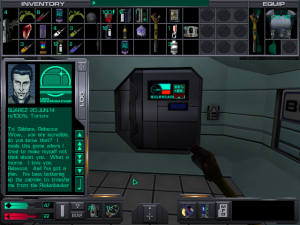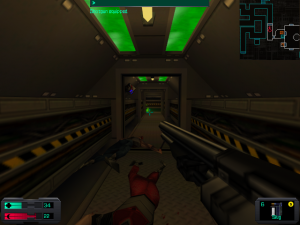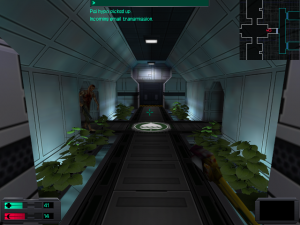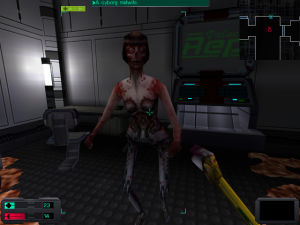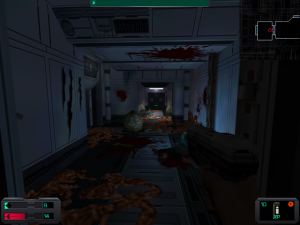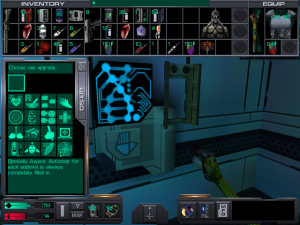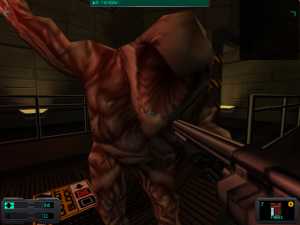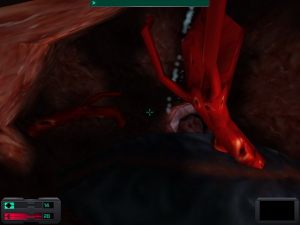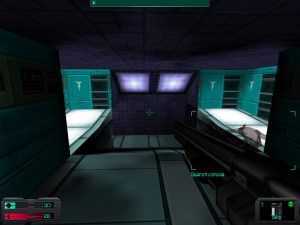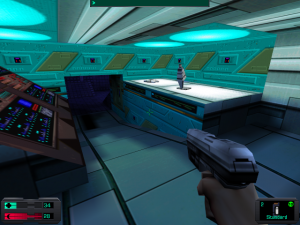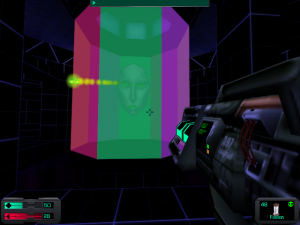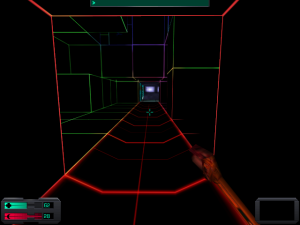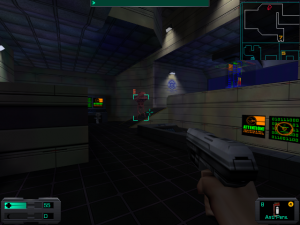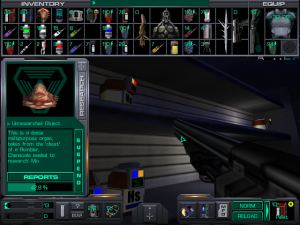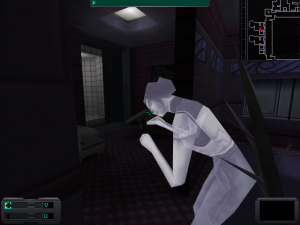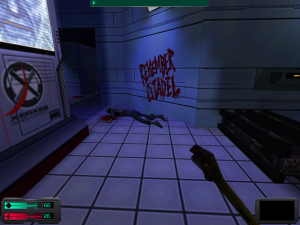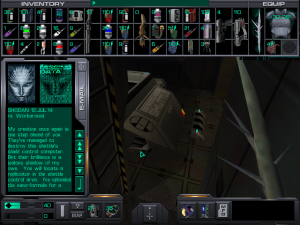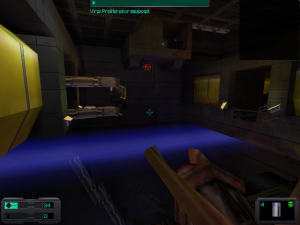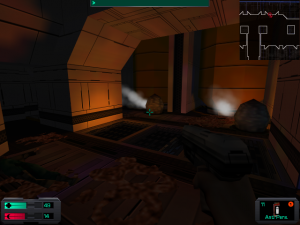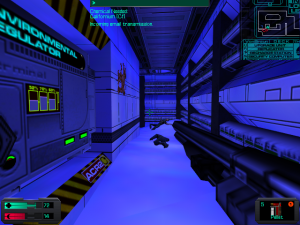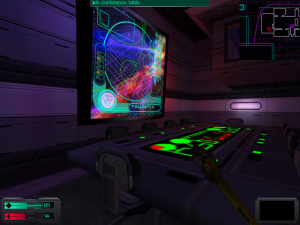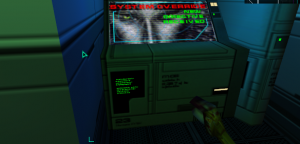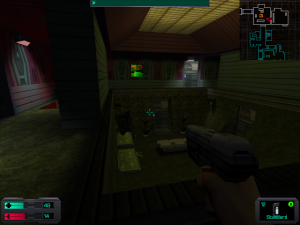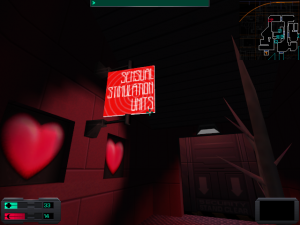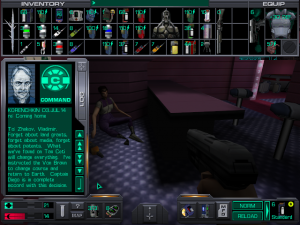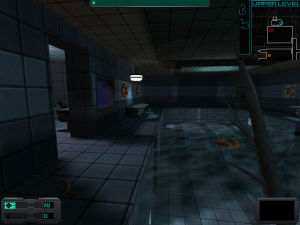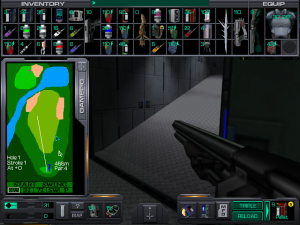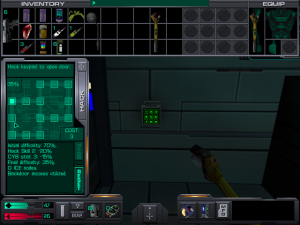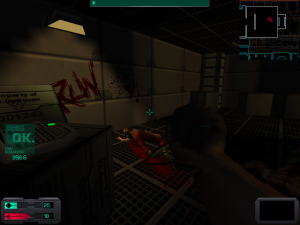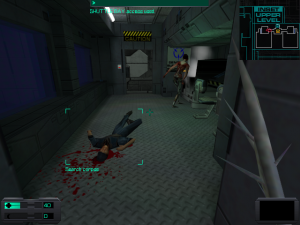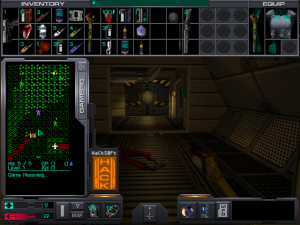- System Shock
- System Shock 2
After the destruction of Citadel Station at the end of System Shock, Trioptimum was dismantled, and a world order established to prevent a similar crisis. 40 years later, however, the Trioptimum name is resurrected, and the company develops the first spaceship capable of lightspeed travel, the Von Braun. During its maiden voyage to the Tau Ceti star system, it’s escorted by military vessel, the Rickenbacker, just in case something goes wrong.
Predictably, something goes wrong.
The player is a military soldier who, due to a computer error, has slept for an extended period of time and wakes up from hypersleep with amnesia. (The player is referred to in game as “the soldier”, and nicknamed “Goggles” by the fanbase, due to the appearance of the cybernetic rig.) During his nap, the ship has fallen into utter chaos, with most of the crew either dead or turned into mutants. The player receives guidance from one of the few survivors, Dr. Janice Polito, who guides them through the infested corridors of the Van Braun, in hopes to not only uncover the origins of this disaster, but also escape with their lives.
As with the original, most of the exposition happens through the transmissions with Dr. Polito as well as the numerous logs found lying throughout. The ship seems to have been taken over by another rogue AI, XERXES, who refers to the monsters aboard the ship as “The Many”.
Anyone who’s seen Alien can probably predict that things started to go wrong when the scientists found some kind of strange lifeform on one of the planets in Tau Ceti. But one of the recordings uncovers something that ties it closely to the first game – a voice that sounds remarkably like SHODAN. Her presence isn’t quite a spoiler, considering she’s lying front and center on the game’s cover.
System Shock 2 was developed by Irrational Games, founded by former members of Looking Glass Studios. The original System Shock was not a commercial success, but the developers decided to create a spiritual sequel with updated technology, and gave it the tentative title Junction Point. However, Electronic Arts signed on as the publisher, and they happened to own the System Shock name due to their purchase of Origin Studios, so the storyline was reworked to be an official sequel to System Shock.
In the five years between the release of System Shock and System Shock 2, there had been huge technological leaps. While the first game was an evolution of the early 3D technology seen in Ultima Underworld, feeling like a realtime first person dungeon crawler, the sequel looks and plays closer to other first person shooters of the era, like Quake 2 and Half-Life. As a result of the smoother controls, there’s a greater focus on action, and the individual Story/Action/Puzzle difficulty levels are gone.
However, this doesn’t mean that System Shock has transformed fully into a first person shooter, because that’s definitely not the case. In fact, despite of the focus on action, there are additional character building elements that make the game feel even more like an RPG.
At the beginning of the game, you can choose from three military careers, which determines your stating stats: the Marines are focused on action and grants higher strength and endurance; the Navy is focused on engineering and gives you greater repair and hacking skills; and the OSA focuses on psionics, the science-fiction equivalent of magic spells, which includes abilities like Projected Cryokinesis, a ranged attack; Adrenaline Overproduction, to power up your melee attacks; Cerebro-stimulated Regeneration, to restore health; Photonic Redirection, to make yourself essentially invisible; Remote Circuitry Manipulation, which lets you hack objects from a distance; Metacreative Barrier, to create temporarily shields; and many more. These are controlled by the psi meter, which serves as the equivalent to magic points.
There are individual stats for Strength, Endurance, Agility, Agility, and Cyber Affinity, plus levels for skills like Hack, Maintenance, Modification, Repair and Research. Weaponry is also divided into proficiency levels for each of the four weapon types – Regular, Energy, Heavy and Exotic – as well as a totally separate skill tree for psionic powers. Throughout the ship there are also OS upgrades, which provide an assortment of specific perks, though these are rare and very limited. Implants can be equipped to boost assorted statistics, though they have their own energy meter rather than sharing one with the player.
Whenever you complete an objective, Dr. Polito will grant you to some Cyber Modules, which can be used to upgrade any of these skills. They can also be found scattered around, as a reward for judicious exploration. Your class only determines your starting statistics, so you can start off focused on fighting and then focus on another field throughout.
There are still security cameras everywhere, but rather than having to destroy them for a vague “security” rating, they work the same way as any other stealth game – if you’re spotted, then it sounds an alarm, summing a horde of enemies to home in on your location for a few minutes. You can wait out the attack, but it’s smarter to hunt down a security system and disable the alert. The inventory has changed into a grid, similar to Diablo. Multiple item types can stack, but weapons tend to take up a lot of spaces, so you can’t carry around too much at the same time.
Vending machines can be found everywhere, offering items ranging from curatives to ammunition. Nanites are the form of currency used for everything from purchasing items to hacking consoles to repairing items. The regeneration chambers work the same way as the original System Shock, though on the higher difficulty levels, you’re also charged a small amount of nanites when you’re killed. Obviously, if you run out, then you’re dead for good.
Hacking is important for a number of reasons. At low levels it can be used for make things cheaper at vending machines, but at higher levels you can disable all security measures for a short period of time, and even reprogram turrets so they’ll attack enemies rather than you. Repair skills are good to have since weapons degrade with use, and break completely if left unmaintained. Modification skills also let you upgrade any weapons you find with additional firepower. More minigames can be found in the form of cartridges for the “Game PIG” console. The best of these is Underworld Zero, similar to the early Ultima games, with randomly generated missions and a relatively large world.
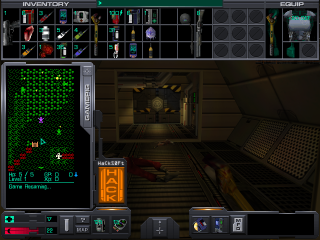 You’ll also find assorted “unresearched artifacts” lying around. Some of these can be automatically studied by your implants, but most require that you hang around in a chemical storage room, of which there is one on each floor, so you can supply the necessary items to finish research. Upon completion, some of these items are revealed as usable weapons, while enemy organs will increase your attack power against them.
You’ll also find assorted “unresearched artifacts” lying around. Some of these can be automatically studied by your implants, but most require that you hang around in a chemical storage room, of which there is one on each floor, so you can supply the necessary items to finish research. Upon completion, some of these items are revealed as usable weapons, while enemy organs will increase your attack power against them.
The puzzles of the first game are gone; instead, any time you need to hack or repair something, you play a small “game” where you’re presented with a grid and need to highlight three boxes in a row. They’re entirely based on luck, based on what you’re trying to do and your skill levels, but most of the time you can reset and try again if things don’t work in your favor. On the other hand, you can also break the item in question if you carelessly click on the wrong box.
It’s impossible to become fully proficient in all areas, so your character will always be underpowered in some way. It does lead to some frustrating moments, especially when you come across some cool weapons but find that your proficiency level is far too low to even equip them. Plus, ammunition is sparse, and unless you upgrade your skills or modify your weapons, you’ll probably spend most of the game bashing enemies with the standard wrench, as it’s the most efficient method from a resource conservation standpoint. Resource management is one of the most important things about the game, both in conserving items and ammunition and properly building your character, but unless you know how to do this, it can lead to some sticky situations. There are way to balance the game in your favor, in some cases making it too easy, but none of these will be apparent to the novice player.
Until you figure those out though, the weakened state of your character does constantly puts you in a state of terror, which something amplified by the enemy designs. There are only a handful throughout the entire game, but all of them elicit fear. The standard mutant grunts beg for their own death even as firing at you with a shotgun. The experiments on monkeys has resulted in a legion of simians with exposed brains who can lob psychic projectiles. The protocol droids all take politely and even wave at you from a distance, but charge at you and then explode, like a suicide bombing C3PO. The cyborg midwives are an unholy mesh of robotic legs and exposed rotting flesh. The cyborg assassins are, literally, ninjas, and aren’t scary for the noises they make, but rather, the ones they don’t.
Being that the game was developed in 1999, the models of the enemies aren’t complex, but it’s one of those cases where the technology actually works in its benefit, since it abstracts their horrific designs to look even more inhuman. (Fan made modification recreate their models with more polygons, but the increased detail doesn’t work in their favor.)
Moreover, the sound design is fantastic. You can hear the ramblings of the mutants or the terrifying screeches of the cyborg midwives even if they’re just lumbering around, hidden around the corner or cloaked in the darkness. Rarely has the chattering of monkeys been so terrifying; you know there’s something in the room waiting to attack, but where?
The music is different from the original, with most of the soundtrack consisting of ambient computer noises and low-key synth, but it kicks into higher gear with techno and drum and bass during combat. It inflicts anxiety even when just wandering around, even if it’s occasionally jarring.
Some aspects of the original game are unfortunately gone. The most conspicuous is the absence of cyberspace, at least technically speaking. (You do enter cyberspace in a few instances, but the controls don’t change, it just changes the textures to look like something out of Tron.) Even though SHODAN is present in the game, and accounts for the game’s coolest twists, XERXES just isn’t remotely on the same level of villainy. There’s no real “game over” cinema when you die, as you just get tossed out into the main menu. Even though your character is still just a blank avatar, casting you as a generic soldier rather than a morally bankrupt hacker is a little more boring. Small touches, like the cheesy music in the elevators, are sorely missed.
Unfortunately the game slightly falters by the end. Much like Half-Life, one of the final areas is a biologically infested level that’s a pain to navigate, and especially annoying due to the lack of resurrection chambers. The final level includes some nice callbacks to the first System Shock, but the ending is jarringly out of place and feels more appropriate for an 80s action movie.
There are some other cool callbacks to the original. The Von Braun is helmed by William Diego, Edward Diego’s son. And while, like most of the characters, he’s long dead before the game begins, his heroic nature serves as a contrast to the corporate scumbag nature of his dad.
Despite feeling like a drastically different game, System Shock 2 is still a clear evolution of the concepts of the first game. While that game definitely aged, a product of its era, the sequel is just as playable today as it was in 1999. It’s dark, scary, compelling, and due to all of the possible character rebuilds, extremely replayable.
When it was initially released, System Shock 2 was criticized for being a little too difficult. A subsequent patch modified the weapon degradation and enemy respawn rates, to make things more manageable. It also added two player co-op multiplayer, which is cool, but it’s always locked to the highest difficulty setting, and the amount of resources haven’t been doubled, so it’s even more of a struggle than single player mode. A Dreamcast port was planned, but cancelled before anything was shown for the public.
System Shock 2 also has a healthy mod scene. Until the game’s official re-release on digital platforms in 2013, it had numerous stability problems on post-Windows 98 systems, requiring fan patches and assorted workarounds to get running. Beyond the aforementioned graphical enhancement patches, which include more detailed character models and higher resolution textures, there have been whole new missions created, some complete with new storylines and voice acting.
Spiritual Successors
Bioshock
Unfortunately, like its predecessor, System Shock 2 wasn’t exactly a commercial success, despite earning numerous critical accolades and a cult following. After developing the two Freedom Force titles, Tribes: Vengeance, and SWAT 4, the team developed Bioshock, a spiritual successor to System Shock 2, published in 2007 by Take 2 Interactive. The head designer was Ken Levine, who was one of the founders of the studio and also designed System Shock 2.
The setting has changed from science fiction to reimagined version of the 1960s, taking place in an underwater city named Rapture. What was meant to be an utopia has fallen into decline after being overrun by junkies addicted to a substance called ADAM. The plot is told in the same way, via audio logs of departed citizens. Much like Polito, the player is guided by the voice of someone named Atlas, who urges the player via radio transmissions to rise up against Andrew Ryan, the founder of Rapture. The major mid game plot twist is essentially identical to the one in System Shock 2.
Many of the systems are similar, albeit refined. Turrets and vending machines can hacked, which is determined by a short puzzle similar to the game Pipe Dream. Researching is handled by taking pictures rather than playing around with chemicals. Rather than psionics, there are an assorted of powers called plasmids, which can do everything from settings things on fire to summoning hordes of bees. Ghosts appear in pretty much the same manner.
However, many aspects have been drastically simplified. While you can still pick up items, there’s no real inventory, as curatives restore health when picked up, and everything else is stored and used automatically when necessary. The skill level limitations are completely gone. You can prioritize the kind of plasmids you find, but by the end of the game you can still equip pretty much everything. Resurrection chambers work similarly, except you’ll always find them at the entrance to an area and they don’t charge any money, so you’re never left in a situation where you can ever truly die.
This is the major difference between System Shock 2 and Bioshock – whereas you were always struggling to survive in the former, the latter is much more forgiving, allowing the game to focus on action rather than resource management. As a result, the game is much less scary. The enemies are mostly just junkies with party masks (the fall of the empire occurred during a New Years Eve celebration), and while they’re weird and unnerving, there’s nothing remotely as nerve wracking as the cyborg midwives. A post-game patch gives you the option to disable the regeneration chambers, but it’s just a band aid over the fact that many elements were overtly simplified. According to interviews, work-in-progress versions of Bioshock included RPG elements similar to System Shock 2, but after some unfavorable focus testing sessions, they were scaled back.
Bioshock 2 offered more of the same, also taking place in Rapture, while a third game, Bioshock Infinite, changed the setting to the airborne city of Columbia. The gameplay is similar, though this game also includes a 1999 mode – a reference to the release year of System Shock 2 – which more drastically limits resources and charges for resurrections, making it slightly more like its spiritual predecessor, even if the character customization abilities have still been dialed back.
Even though many long time prefer System Shock 2 for its atmosphere and difficulty, the Bioshock games shouldn’t be discounted. The settings for both games are incredibly original, with some of the best design and architectural work seen in a video game. Moreover, the storyline deals with different themes rarely touched by other video games, satirizing elements of the extremist right wing politics that began to become more prominent in early 21st century America. The city of Rapture from the original Bioshock is inspired by Galt’s Gulch, the libertarian paradise from Ayn Rand’s Atlas Shrugged, and illustrates why those philosophies just don’t work in real life. Bioshock Infinite takes on nationalist movements like the Tea Party by portraying a group who literally deifies the founding fathers of America and uses patriotism and religion to justify racial superiority. Meanwhile, the Vox Populi, the resistance movement, has some commonalities with the 2011 Occupy Wall Street movement. While the themes don’t always work – complicated storytelling in video games still has a long way to go to reach literary levels – it makes the science fiction setting of the System Shock games seem generic by comparison.
Dead Space
In 2006, Electronic Arts renewed the System Shock license, causing some to speculate that they themselves would be creating their own third entry, in spite of 2K’s work on Bioshock. That never came to fruition, but they in 2007 they did release Dead Space, developed by an internal studio named Visceral Games.
While not as explicitly patterned after System Shock 2 in the same way that Bioshock was, there are definitely some traces of inspiration. While the game is a third person shooter, closer to Resident Evil 4, rather than a first person shooter, it also takes place on a space vessel which has been taken over by an alien force. Most of the survival elements missing from Bioshock can be found in Dead Space, as you’re constantly struggling for health, ammo, and items to upgrade your stats. It’s a much bloodier and scarier game too, with an assorted of horrific creations and brutal death scenes. However, like many sequels, the series was dumbed down as it went along, focusing more on run-and-gun action, thus losing most of what made the first game so appealing.
